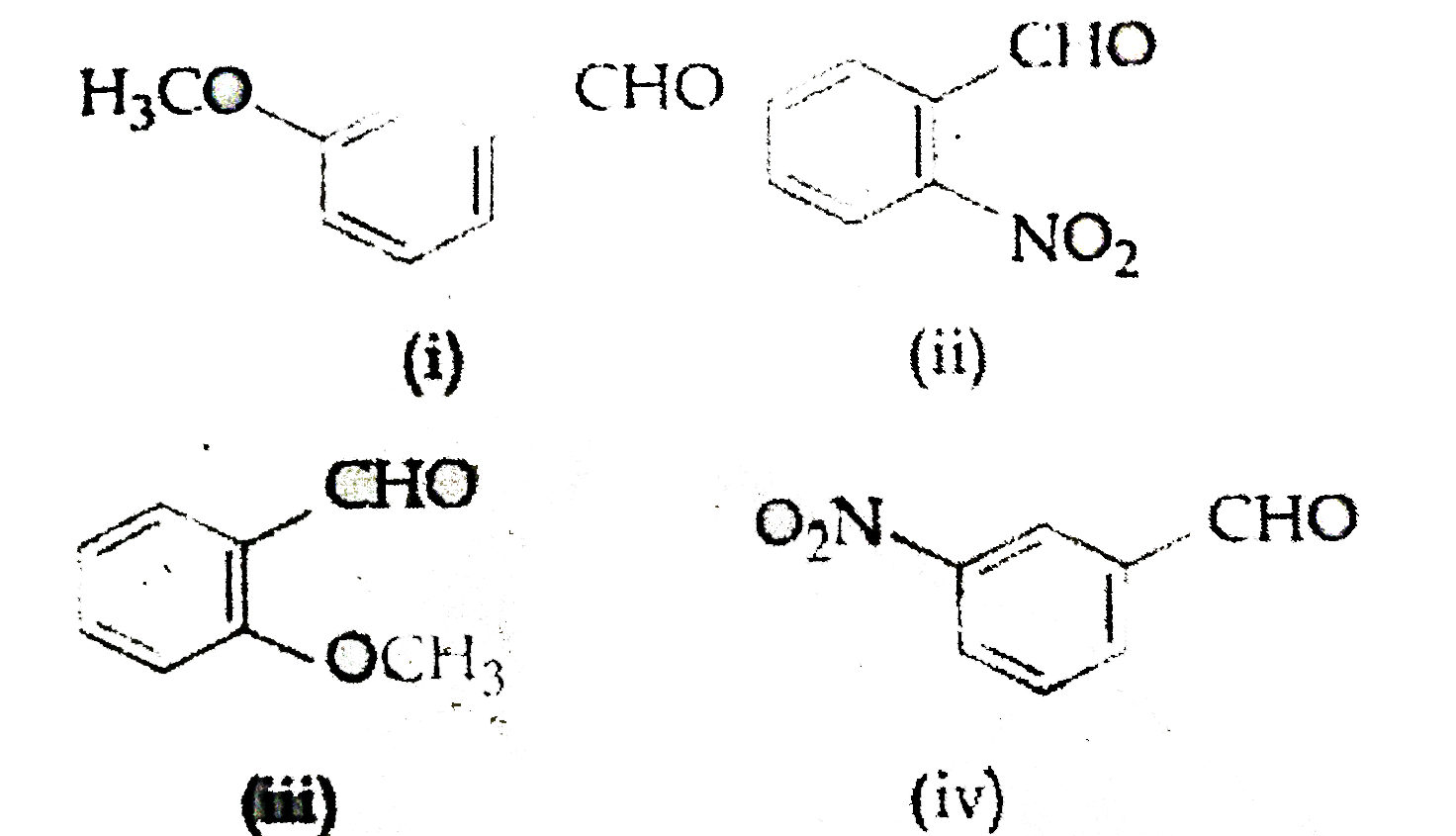The increasing order of the rate of HCN addition of compound a-d is
(i) HCHO
(ii) CH3COCH3
(iii) PhCOCH3
(iv) PhCOPh
(i)<(ii)<(iii)<(iv)
(iv)<(ii)<(iii)<(i)
(iv)<(iii)<(ii)<(i)
(iii)<(iv)<(ii)<(i)
The correct Answer is:C
To determine the increasing order of the rate of HCN addition to the compounds given (HCHO, CH₃COCH₃, PhCOCH₃, PhCOPh), we need to analyze the structure of each compound and the steric hindrance involved in the addition reaction. Here’s a step-by-step solution:
Step 1: Identify the Compounds
1. HCHO (Formaldehyde): This is an aldehyde with no alkyl groups attached to the carbonyl carbon.
2. CH₃COCH₃ (Acetone): This is a ketone with two methyl groups attached to the carbonyl carbon.
3. PhCOCH₃ (Acetophenone): This is a ketone with one phenyl group and one methyl group attached to the carbonyl carbon.
4. PhCOPh (Benzophenone): This is a ketone with two phenyl groups attached to the carbonyl carbon.
Step 2: Analyze the Reactivity
- HCHO: The carbonyl carbon is less sterically hindered because it has two hydrogen atoms. Thus, it is the most reactive towards HCN addition.
- CH₃COCH₃: The carbonyl carbon is attached to two methyl groups. Although it has some steric hindrance, it is still less hindered compared to the compounds with phenyl groups. Therefore, it is the second most reactive.
- PhCOCH₃: The presence of one phenyl group introduces more steric hindrance than the two methyl groups in acetone. Hence, it is less reactive than acetone but more reactive than benzophenone.
- PhCOPh: This compound has two phenyl groups, which create significant steric hindrance around the carbonyl carbon, making it the least reactive towards HCN addition.
Step 3: Order the Reactivity
Based on the analysis:
1. HCHO (most reactive)
2. CH₃COCH₃
3. PhCOCH₃
4. PhCOPh (least reactive)
Conclusion
The increasing order of the rate of HCN addition to the compounds is:
PhCOPh < PhCOCH₃ < CH₃COCH₃ < HCHO
Final Answer
The increasing order of the rate of HCN addition is: PhCOPh < PhCOCH₃ < CH₃COCH₃ < HCHO.
---
1. HCHO (Formaldehyde): This is an aldehyde with no alkyl groups attached to the carbonyl carbon.
2. CH₃COCH₃ (Acetone): This is a ketone with two methyl groups attached to the carbonyl carbon.
3. PhCOCH₃ (Acetophenone): This is a ketone with one phenyl group and one methyl group attached to the carbonyl carbon.
4. PhCOPh (Benzophenone): This is a ketone with two phenyl groups attached to the carbonyl carbon.
- HCHO: The carbonyl carbon is less sterically hindered because it has two hydrogen atoms. Thus, it is the most reactive towards HCN addition.
- CH₃COCH₃: The carbonyl carbon is attached to two methyl groups. Although it has some steric hindrance, it is still less hindered compared to the compounds with phenyl groups. Therefore, it is the second most reactive.
Based on the analysis:
1. HCHO (most reactive)
2. CH₃COCH₃
3. PhCOCH₃
4. PhCOPh (least reactive)
The increasing order of the rate of HCN addition to the compounds is:
PhCOPh < PhCOCH₃ < CH₃COCH₃ < HCHO
The increasing order of the rate of HCN addition is: PhCOPh < PhCOCH₃ < CH₃COCH₃ < HCHO.
Topper's Solved these Questions
- BOOK - BITSAT GUIDECHAPTER - ALDEHYDE AND KETONESEXERCISE - Bitsat Archives14videos
ALDEHYDE AND KETONES
- BOOK - BITSAT GUIDECHAPTER - ALCOHOLS, PHENOLS AND ETHERSEXERCISE - BITSAT Archives14videos
ALCOHOLS, PHENOLS AND ETHERS
- BOOK - BITSAT GUIDECHAPTER - CARBOXYLIC ACID AND DERIVATIVESEXERCISE - All Questions34videos
CARBOXYLIC ACID AND DERIVATIVES
Similar Questions
Knowledge Check
- Question 1 - Select One
The increasing order of the rate of HCN addition of compound a-d is
(i) HCHO
(ii) CH3COCH3
(iii) PhCOCH3
(iv) PhCOPhAiv<ii<iii<iBiv<iii<ii<iCiii<iv<ii<iDi<ii<iii<iv. - Question 2 - Select One
The increasing order of the rate of HCN addition to compound A-D is
(A) HCHO
(B) CH3COOH3
( C) PhCOCH3
(D) PhCOPhAA<B<C<DBD<B<C<ACD<C<B<ADC<D<B<A - Question 3 - Select One
The increasing order of the rate of HCN addition to compound A-D is
(A)HCHO , (B)CH3COCH3 , (C ) PhCOCH3 , (D)PhCOPhAD lt Clt Blt ABC lt D lt B lt ACA lt B lt C lt DDD lt B lt C lt A
The increasing order of the rate of HCN addition compound A−D is
A. HCHO
B. CH3COCH3
C. PhCOCH3
D. PhCOPhView SolutionThe increasing order of the rate of HCN addition compound A−D is
A. HCHO
B. CH3COCH3
C. PhCOCH3
D. PhCOPhView SolutionThe increasing order of the rate of HCN addition to compounds A to D is
A.HCHOB.CH3COCH3C.PhCOCH3D.PhCOPhView SolutionArrange the following compounds in decreasing orders of rate of hydration.
(X)CCl3CHO (Y)CH3CHO (Z)CH3COCH3 (W)CF3CHOView SolutionThe correct order of solubility of following compound is
(1) H−CHO (2)CH3−CHO
(3) CH3−CH2−CHO (4)CH3−COCH3View Solution


